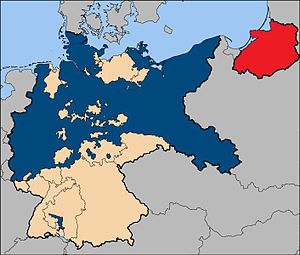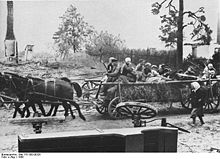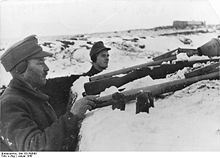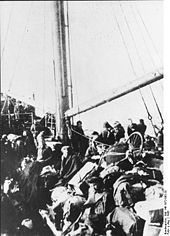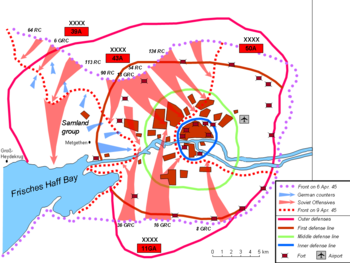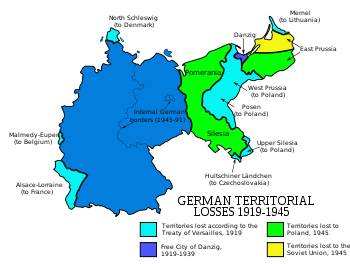- Evacuation of East Prussia
-
Evacuation of East Prussia Part of World War II
East Prussia (red), is located 340km east of the current Polish-German borderDate January–March 1945 Location East Prussia Result Evacuation of over 1.8 million German civilians [1] Belligerents  Germany
Germany Soviet Union
Soviet UnionCommanders and leaders  Gauleiter Erich Koch
Gauleiter Erich Koch Ivan Chernyakhovsky
Ivan Chernyakhovsky
 Aleksandr Vasilevsky (commanders of the Soviet invading troops)
Aleksandr Vasilevsky (commanders of the Soviet invading troops)Casualties and losses  25,000-30,000[2][3][4] [5]
25,000-30,000[2][3][4] [5]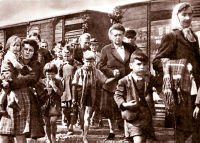
Flight and expulsion of Germans
during and after World War II(demographic estimates) Background German exodus from Eastern Europe
Nazi-Soviet population transfers
Potsdam AgreementWartime flight and evacuation German evacuation
East PrussiaPost-war flight and expulsion Czechoslovakia
Poland (incl. former German territories)
Netherlands
RomaniaLater emigration Emigration from Poland The evacuation of East Prussia refers to the evacuation of the German civilian population and military personnel in East Prussia and the Klaipėda region between 20 January, and March 1945, as part of the evacuation of German civilians towards the end of World War II. It is not to be confused with the expulsion after the war had ended, under Soviet occupation.
The evacuation, which had been delayed for months, was initiated due to fear of the Red Army advances during the East Prussian Offensive. Some parts of the evacuation were planned as a military necessity, Operation Hannibal being the most important military operation involved in the evacuation. However, many refugees took to the roads on their own because of reported Soviet atrocities against Germans in the areas under Soviet control. Allegations of Soviet atrocities were disseminated not only through the official news and propaganda outlets of the Third Reich, but also by rumors that swept through the military and civilian population.
Despite having detailed evacuation plans for some areas, authorities of the Third Reich, including the Gauleiter of East Prussia, Erich Koch, delayed action until January 20, when it was too late for an orderly evacuation, and the civil services were eventually overwhelmed by the huge number of those wishing to evacuate. Coupled with the panic caused by the speed of the Soviet advance, civilians caught in the middle of combat, and the bitter winter weather, many thousands of refugees died during the evacuation period. The Soviets took complete control of East Prussia in May 1945. A large part of the German civil population of about 2.5 million managed to evacuate, though about 25,000-30,000[6][7] were killed during the Soviet offensive. [8][9] In May 1945 Soviet authorities registered 193,000 Germans in East Prussia but an estimated number of 800,000 managed to return after the end of military actions,[10] who were later expelled by the Soviet and Polish authorities. The Polish census of 1950 indicated that 164,000 of the former German population remained in East Prussia.[11] Most later emigrated to Germany.
Contents
Propaganda
German
The Soviet army initiated an offensive into East Prussia in October 1944, but it was temporarily driven back two weeks later. After that, the German Ministry of Propaganda reported that war crimes had taken place in East Prussian villages, in particular in Nemmersdorf, where (according to the Ministry) inhabitants had been raped and killed by the advancing Soviets.[12] Since the Nazi war effort had largely stripped the civil population of able-bodied men for service in the military, the victims of the atrocity were primarily old men, women, and children. Upon the Soviet withdrawal from the area, German authorities sent in film crews to document what had happened, and invited observers as further witnesses. A documentary film from the footage obtained during this effort was put together and shown in cinemas in East Prussia, with the intention of hardening civilian and military resolve in resisting the Soviets.[13] Nazi propaganda about the atrocities at Nemmersdorf, as well as on other crimes committed in East Prussia, convinced the remaining civilians that they should not get caught by the advancing enemy.[14]
Soviet
Since many Soviet soldiers had lost family and friends during the German invasion and partial occupation of the USSR (about 17 million Soviet civilians plus 10 million Soviet soldiers died in World War II, more, in absolute terms, than in any other country[15]), many felt a desire for vengeance. Murders of Axis prisoners of war and German civilians are known from cases at Soviet military tribunals. Also, when Soviet troops moved into East Prussia, large numbers of enslaved Ostarbeiter ("Eastern workers") were freed, and knowledge of the suffering and deaths of many of these workers hardened the attitude of many Soviet soldiers towards East Prussians.[16]
Lev Kopelev, who took part in the invasion of East Prussia, sharply criticized atrocities against the German civilian population. For this he was arrested in 1945 and sentenced to a ten-year term in the Gulag for "bourgeois humanism" and for "pity for the enemy".[17] Aleksandr Solzhenitsyn also served in East Prussia in 1945 and was arrested for criticizing Joseph Stalin and Soviet crimes in private correspondence with a friend. Solzhenitsyn was sentenced to an eight-year term in a labor camp.[18]
Evacuation
The evacuation plans for parts of East Prussia were ready in the second half of 1944. They consisted of both general plans and specific instructions for many towns. The plans encompassed not only civilians, but also industry and livestock.[19]
Initially, Erich Koch, the Gauleiter of East Prussia, did not agree to the evacuation of the civilians (until 20 January 1945), and ordered that civilians trying to flee the region without permission would be instantly shot. Any kind of preparations made by civilians were treated as defeatism and "Wehrkraftzersetzung" (undermining of military morale). This did not, however, prevent Koch and many other Nazi functionaries from being among the first to flee during the Soviet advance. However, between 12 January and mid-February 1945, almost 8.5 million Germans fled the Eastern provinces of the Reich.[1][20] Most of the refugees were women and children heading to western parts of Germany, carrying goods on improvised means of transport, such as wooden wagons and carts, as all the motorized vehicles and fuel had been confiscated by the Wehrmacht at the beginning of the war. After the Red Army reached the coast of the Vistula Lagoon near Elbing on January 23, 1945, cutting off the overland route between East Prussia and the western territories,[21] the only way to leave was to cross the frozen Vistula Lagoon to reach the harbours of Danzig/Gdańsk or Gdingen/Gdynia to be evacuated by ships taking part in Operation Hannibal. Mingled with retreating Wehrmacht units,and without any camouflage or shelter, the refugees were attacked by Soviet bombers and fighter aircraft. Many wagons broke through the bomb-riddled ice covering the brackish water. Also horses and caretakers from the Trakehner stud farms were evacuated with the wagon trains. The evacuation was severely hampered by Wehrmacht units, which clogged roads and bridges.
The remaining men aged 16 – 60 were immediately incorporated into the Volkssturm. However, some Volkssturm members, without basic military knowledge and training, escaped into the woods, hoping to simply survive.[22] Refugee trains leaving East Prussia were also extremely crowded, and due to the very low temperatures, children often froze to death during the journey. The last refugee train left Königsberg on January 22, 1945.[23]
Military writer Antony Beevor wrote, in Berlin the Downfall, that:[24]
Martin Bormann, the Reichsleiter of the National Socialist Party, whose Gauleiters had in most cases stopped the evacuation of women and children until it was too late, never mentions in his diary those fleeing in panic from the eastern regions. The incompetence with which they handled the refugee crisis is chilling, yet in the case of the Nazi hierarchy it is often hard to tell where irresponsibility ended and inhumanity began.
Operation Hannibal
Operation Hannibal was a military operation that started on January 21, 1945, on the orders of Admiral Karl Dönitz, withdrawing German troops and civilians from East Prussia. The flood of refugees turned the operation into one of the largest emergency evacuations by sea in history — over a period of 15 weeks, somewhere between 494 and 1,080 merchant vessels of all types and numerous naval craft, including Germany's largest remaining naval units, would transport about 800,000 - 900,000 refugees and 350,000 soldiers [25] across the Baltic Sea to Germany and occupied Denmark.[26] This evacuation was one of the German Navy's most significant achievements during the war.[27]
The greatest recorded maritime disaster in history occurred during this operation, when the passenger ship Wilhelm Gustloff was hit by three torpedoes from the Soviet submarine S-13 in the Baltic Sea on the night of 30 January 1945. She sank in under 45 minutes; figures for the number of deaths vary, from possibly more than 5,300,[28][29] to 7,000[30] or 7,400.[31] The 949 survivors[32] were rescued by Kriegsmarine vessels led by cruiser Admiral Hipper,[31] although it is claimed that "the big warship could not risk heaving to, with a submarine close by."[33] Also, on 14 February, the SS General von Steuben left Pillau with 2,680 refugees onboard; it was hit by torpedoes just after departure, killing almost all aboard.[34]
Königsberg
On January 24, 1945, the 3rd Belorussian Front led by General Chernyakhovsky, surrounded the capital city of East Prussia, Königsberg. The 3rd Panzer Army and around 200,000 civilians were trapped inside the city.[35] In response to this, General Georg-Hans Reinhardt, commander of the Army Group Center, warned Hitler of the imminent Soviet threat, but the Führer refused to act. Due to the rapid approach of the 2nd Belorussian Front led by General Rokossovsky, Nazi authorities in Königsberg decided to send trains full of refugees to Allenstein, without knowing that the town had already been captured by the Soviet 3rd Guards Cavalry Corps.[17]
During the Soviet assault, the Frische Nehrung spit became the last means of escape to the west. However, civilians which tried to escape along the spit were often intercepted and killed by Soviet tanks and patrols.[36] Two thousand civilians left Königsberg every day and tried to reach the already crowded town of Pillau. The final Soviet assault on Königsberg started on 2 April with a heavy bombardment of the city. The land route to Pillau was once again severed and those civilians who were still in the city died in their thousands. Eventually, the Nazi garrison surrendered on April 9, and as Beevor wrote, "the rape of women and girls went unchecked in the ruined city"[37]
Crimes
The widely-publicized killings and rapes in places like Nemmersdorf by the Soviets led to a severe degree of fear in the entire German population of East Prussia. Even enslaved Soviet women liberated by Soviet troops were often raped by Soviet soldiers. Beevor argues that these acts of violence were motivated by a desire for revenge and retribution for crimes committed by the Nazis during their invasion of Soviet Union.[38]
War reporter Vasily Grossman said that the rear-guard units of the advancing Soviet armies were usually responsible for a large number of the crimes committed by Red Army personnel. Wealthy civilians of East Prussia were often shot by Soviet soldiers, their goods stolen, and their houses set on fire, as a result of Soviet propaganda advocating the eradication of the aristocracy.[39] Soviet Officers like Lev Kopelev, who tried to prevent crimes, were accused of mercy with the enemy and became Gulag prisoners.
Aftermath
The Red Army eliminated all pockets of resistance and took control of East Prussia in May 1945. The exact number of civilian dead has never been determined, but is estimated to be at least 300,000, with most of them dying under miserable conditions. However, most of the German inhabitants, which at that point consisted mainly of children, women, and old men, did escape the Red Army as part of the largest exodus of people in human history.[40] As Antony Beevor also said:[41]
“ A population which had stood at 2.2 million in 1940 was reduced to 193,000 at the end of May 1945. ” Based on West German Statistisches Bundesamt figures from 1958, in total, out of a pre-war population of 2,490,000 about 500,000 died during the war,including military dead and civilians, 311,000 civilians dying during the wartime flight and postwar expulsion of Germans; 1,200,000 managed to escape to the western parts of Germany, while about 800,000 pre-war inhabitants remained in East Prussia in summer 1945. The figure of 311,000 civilian deaths is included in the overall estimate of 2.2 million expulsion deaths that is often cited in historical literature.[42].[43]
According to other sources in summer 1945 about 800,000 Germans were still living in East Prussia.[10] The Red Army's brutality towards civilians during the East Prussian campaign, coupled with years of Nazi propaganda regarding the Soviet Union, led many German soldiers on the Eastern Front to believe that "there could be no purpose in surviving Soviet victory". This belief motivated many German soldiers to continue fighting even though they believed that the war was lost, and this contributed to higher Soviet casualties.[32]
Most Germans who were not evacuated during the war were expelled from East Prussia and the other former German territories east of the Oder-Neisse line in the years immediately after the end of World War II, as agreed to by the Allies at the Potsdam conference, because in the words of Winston Churchill:[44]
“ Expulsion is the method which, in so far as we have been able to see, will be the most satisfactory and lasting. There will be no mixture of populations to cause endless trouble. A clean sweep will be made. ” After World War II, as also agreed at the Potsdam Conference (which met from 17 July until 2 August 1945), all of the area east of the Oder-Neisse line, whether recognized by the international community as part of Germany before 1933 or occupied by Germany during World War II, was placed under the jurisdiction of other countries. The relevant paragraph regarding East Prussia in the Potsdam Agreement is:[45]
V. City of Koenigsberg and the adjacent area.
The Conference examined a proposal by the Soviet Government to the effect that pending the final determination of territorial questions at the peace settlement, the section of the western frontier of the Union of Soviet Socialist Republics which is adjacent to the Baltic Sea should pass from a point on the eastern shore of the Bay of Danzig to the east, north of Braunsberg-Goldap, to the meeting point of the frontiers of Lithuania, the Polish Republic and East Prussia.
The Conference has agreed in principle to the proposal of the Soviet Government concerning the ultimate transfer to the Soviet Union of the City of Koenigsberg and the area adjacent to it as described above subject to expert examination of the actual frontier.
The President of the United States and the British Prime Minister have declared that they will support the proposal of the Conference at the forthcoming peace settlement.See also
Notes
- ^ a b Beevor, (Ro) p.83
- ^ Die deutschen Vertreibungsverluste. Bevölkerungsbilanzen für die deutschen Vertreibungsgebiete 1939/50. Herausgeber: Statistisches Bundesamt - Wiesbaden. - Stuttgart: Verlag W. Kohlhammer, 1958 The German government claimed total civilian losses in East Prussia of 299,200 including 274,200 in the expulsions after May 1945 and 25,000 during the war
- ^ Wirtschaft und Statistik 1958, 602, 603
- ^ The German Federal Archives estimated that about 1% (100-120,000 of the estimated 11-12 million total German civilian population) in the of the Oder Neisse region lost their lives due military activity in the 1944-45 campaign as well as deliberate killings by Soviet forces. Spiegel, Silke. ed. Vertreibung und Vertreibungsverbrechen 1945-1948. Bericht des Bundesarchivs vom 28. Mai 1974. Archivalien und ausgewählte Erlebnisberichte.. Bonn: Kulturstiftung der deutschen Vertriebenen. (1989). ISBN 3-88557-067-X. pages 38-41
- ^ Schieder commission Bundesministerium für Vertriebene, Dokumentation der Vertreibung der Deutschen aus Ost-Mitteleuropa Vol. 1 Bonn, 1954 The Schieder commission estimated casualties in the 1945 campaign at 30,000 civilian dead in East Prussia(page 39) and overall civilian losses in entire Oder-Neisse region at 75-100,000 (page 65)
- ^ Die deutschen Vertreibungsverluste. Bevölkerungsbilanzen für die deutschen Vertreibungsgebiete 1939/50. Herausgeber: Statistisches Bundesamt - Wiesbaden. - Stuttgart: Verlag W. Kohlhammer, 1958 The German government claimed total civilian losses in East Prussia of 299,200 including 274,200 in the expulsions after May 1945 and 25,000 during the war
- ^ Wirtschaft und Statistik 1958, 602, 603
- ^ The German Federal Archives estimated that about 1% (100-120,000 of the estimated 11-12 million total German civilian population) in the of the Oder Neisse region lost their lives due military activity in the 1944-45 campaign as well as deliberate killings by Soviet forces. Spiegel, Silke. ed. Vertreibung und Vertreibungsverbrechen 1945-1948. Bericht des Bundesarchivs vom 28. Mai 1974. Archivalien und ausgewählte Erlebnisberichte.. Bonn: Kulturstiftung der deutschen Vertriebenen. (1989). ISBN 3-88557-067-X. pages 38-41
- ^ Schieder commission Bundesministerium für Vertriebene, Dokumentation der Vertreibung der Deutschen aus Ost-Mitteleuropa Vol. 1 Bonn, 1954 The Schieder commission estimated casualties in the 1945 campaign at 30,000 civilian dead in East Prussia(page 39) and overall civilian losses in the entire Oder-Neisse region at 75-100,000 (page 65)
- ^ a b Andreas Kossert, Damals in Ostpreussen, p. 168, München 2008 ISBN 978-3-421-04366-5
- ^ Richard Overy, The Penguin Historical Atlas of the Third Reich, Penguin Books, London, UK, 1996, p.111
- ^ Beevor, p.3,4
- ^ Beevor, (Ro) p.72
- ^ Beevor, (Ro) p.185
- ^ G. I. Krivosheev. Soviet Casualties and Combat Losses. Greenhill 1997 ISBN 1-85367-280-7
- ^ Beevor, (Ro) pp.75-82
- ^ a b Beevor, (Ro) p.73
- ^ Beevor, (Ro) p.176
- ^ Nitschke, p.43
- ^ Overy, Richard, The Penguin Historical Atlas of the Third Reich, Penguin Books, London, UK, 1996, p.111. Overy notes the total pre-war German population of East Prussia as about 2.9 million, so the rest of those making up Beevor's 8.5 million must be from other places, such as Poland and Czechoslovakia (with a combined pre-war ethnic German population of just over 8 million).
- ^ Jürgen Manthey, Königsberg, dtv Verlag München 2006, p. 669
- ^ Beevor, (Ro) p.96
- ^ Jürgen Manthey, p. 669
- ^ Beevor, p.75
- ^ Andreas Kossert, Damals in Ostpreussen, p. 160, München 2008 ISBN 978-3-421-04366-5
- ^ Williams, David, Wartime Disasters at Sea, Patrick Stephens Limited, Nr Yeovil, UK, 1997, p.225 (figure of 494 merchant vessels); Brustat-Naval, Fritz, Unternehmen Rettung, Koehlers Verlagsgeschellshaft, Herford, Germany, 1985, p.240 (figure of 790 vessels of all types); Koburger, Charles W., Steel Ships, Iron Crosses, and Refugees, Praeger Publishers, NY, 1989, p.92 (figure of 1,080 merchant vessels).
- ^ Hastings, p.331
- ^ Irwin J. Kappes states 5,348. He does not cite his sources but recommends: A. V. Sellwood, The Damned Don't Drown: The Sinking of the Wilhelm Gustloff (a fiction title about the tragedy); and Alfred-Maurice de Zayas, A Terrible Revenge: The Ethnic Cleansing of the East European Germans 1944-1950.
- ^ Jason Pipes, citing Heinz Schon (no page number) claims the loss of life was 9,343
- ^ Hastings, p.331.
- ^ a b Beevor, (Ro) p.101
- ^ a b Hastings, p.341.
- ^ Hastings, p.330.
- ^ Beevor, (Ro) p.147
- ^ Beevor, (Ro) p.68
- ^ Beevor, (Ro) p.84
- ^ Beevor, p.188
- ^ Beevor, (Ro) p.75
- ^ Beevor, (Ro) p.109
- ^ Beevor, Antony, chapters 1-8
- ^ Beevor, p. 420
- ^ Die deutschen Vertreibungsverluste. Bevölkerungsbilanzen für die deutschen Vertreibungsgebiete 1939/50. Herausgeber: Statistisches Bundesamt - Wiesbaden. - Stuttgart: Verlag W. Kohlhammer, 1958 The German government claimed total civilian losses in East Prussia of 299,200 including 274,200 in the expulsions after May 1945 and 25,000 during the war
- ^ Kossert, Damals ..., p. 168
- ^ Murphy, Clare (2004-08-02). "World War II expulsions spectre lives on". BBC News (bbc.co.uk). http://news.bbc.co.uk/1/hi/world/europe/3528506.stm. Retrieved 2008-06-25.
- ^ Agreements of the Berlin (Potsdam) Conference
References
- Beevor, Antony. Berlin: The Downfall 1945, Penguin Books, 2002, ISBN 0-670-88695-5
- Beevor, Antony. Berlin: The Downfall 1945, Romanian translation.
- Hastings, Max (2004). Armageddon. The Battle for Germany 1944—1945. London: Macmillan. ISBN 0330490621.
Further reading
- de Zayas, Alfred-Maurice. A Terrible Revenge:The Ethnic Cleansing of the East European Germans, 1944-1950, 1994,ISBN 0-312-12159-8
- Duffy, Christopher (1993). Red Storm on the Reich. The Soviet March on Germany, 1945. Da Capo Press. ISBN 0415035899.
- Glantz, David M. The Soviet‐German War 1941–45: Myths and Realities: A Survey Essay
- Hitchcock, William I. The Struggle for Europe: The Turbulent History of a Divided Continent 1945-2002, 2003, ISBN 0-385-49798-9
- Walter, Elizabeth B. Barefoot in the Rubble, 1997, ISBN 0-9657793-0-0
External links
Categories:- East Prussia
- History of Prussia
- Lithuania Minor
- Germany–Soviet Union relations
Wikimedia Foundation. 2010.

